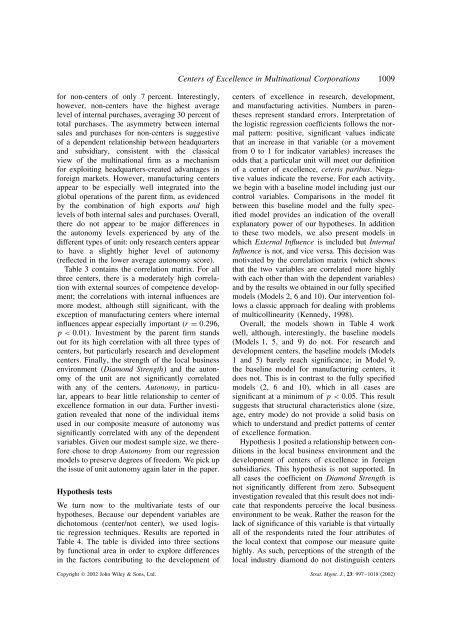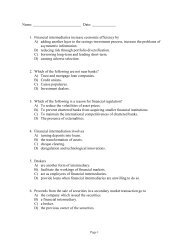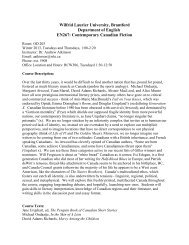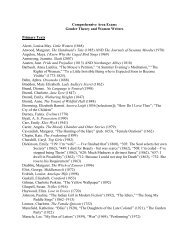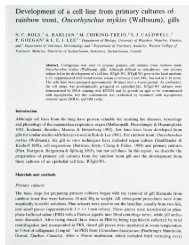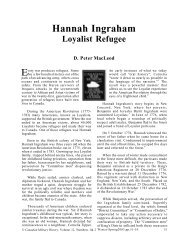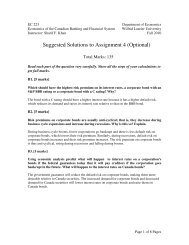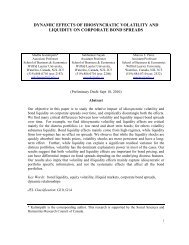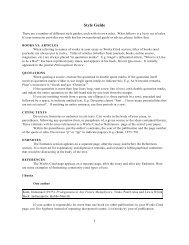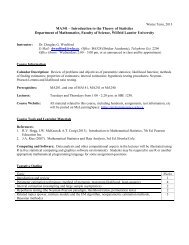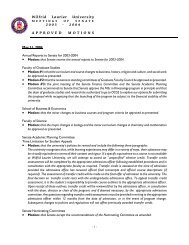1008 T. S. Frost, J. M. Birkinshaw and P. C. Ensignand Capron, Dussauge, and Mitchell (1998) hashighlighted the role of technological assets ofacquiring and target firms. Acquisitions may beparticularly favored when the capabilities of thetarget firm would be difficult to develop internally(for example, where intangibles are key) and whenthe acquiring firm has few technological capabilitiesof their own (Granstrand and Sjölander, 1990).Based on field interviews and our general knowledgeof the Canadian context, we do not havea strong prediction about the role of entry modein the development of centers of excellence. Wehave seen centers of excellence in units establishedthrough greenfield investment and acquisition.However, to ensure that entry mode is notdriving our results, we controlled for it by creatinga dummy variable that takes on the value of1 if the unit was established through greenfieldinvestment, and 0 otherwise.RESULTSWe begin by presenting descriptive statistics oncenters of excellence in each of the three functionalareas. These are presented in Table 2. In addition,we provide a set of comparison points with thoseunits that do not meet our three element definitionof a center (‘non-centers’ in Table 2). Thesestatistics reveal interesting differences across thethree types of centers of excellence as well as substantialdifferences between centers (of any kind)and non-centers. In terms of size, manufacturingcenters are the largest, with average sales in1997 of over C $300 million compared to lessthan C $100 million for both research and developmentcenters. Non-centers are in the middle atC $179.2 million. A similar pattern is reflected inthe number of employees, with manufacturing centersaveraging 774 employees compared to 436 and404 for research and development centers, respectively.Non-centers were again in the middle at 558employees, on average. Research and developmentcenters are also younger (19 years and 27 yearsold, on average, respectively) and more likely to beformed within an acquired subsidiary than a greenfieldsubsidiary. This finding accords with recentwork in strategic management on internationalacquisitions that has highlighted the importanceof technology-seeking motivations for cross-borderM&A (Capron et al., 1998; Inkpen, Sundaram andRockwood, 2000; Teece, 1992). Manufacturingcenters average about 35 years old, the same asnon-centers, with a closer split between greenfieldand acquisition (55% acquisition).Centers of excellence in all three areas aremore export oriented than non-centers. This isnot surprising in light of our earlier discussionon the evolution of multinational firms frommultidomestic-type strategies and structures tomore global and transnational-type structures(Bartlett and Ghoshal, 1989). As noted earlier,centers of excellence are seen by many scholarsas an important manifestation of the transitionto more globally rationalized structures forinnovation, production, and distribution. Furtherevidence of this trend comes from the statisticson internal sales and purchases. Developmentand manufacturing centers sell significantly moreof their output internally (i.e., to other unitsof the multinational firm) than do non-centers:19 percent of total sales for manufacturing centers(14% for development centers) vs. an averageTable 2.Descriptive statistics: centers of excellence vs. non-centers ∗Activity Research Development Manufacturing AllCenter Center Center Non-CentersSales revenue ($C million) 78.6 85.5 300.8 179.2Employees (#) 436 404 774 558Age (years) 19 27 34 35Acquisition (%) 65 64 55 56Exports (%) 34.8 36.7 38.6 25.4Internal purchases (%) 9 15 26 30Internal sales (%) 10 14 19 7Autonomy † 1.87 2.00 2.01 2.02∗ All statistics shown are means, except where noted.† Average response to five questions (lower numbers indicate more autonomy).Copyright © 2002 John Wiley & Sons, Ltd. Strat. Mgmt. J., 23: 997–1018 (2002)
Centers of Excellence in Multinational Corporations 1009for non-centers of only 7 percent. Interestingly,however, non-centers have the highest averagelevel of internal purchases, averaging 30 percent oftotal purchases. The asymmetry between internalsales and purchases for non-centers is suggestiveof a dependent relationship between headquartersand subsidiary, consistent with the classicalview of the multinational firm as a mechanismfor exploiting headquarters-created advantages inforeign markets. However, manufacturing centersappear to be especially well integrated into theglobal operations of the parent firm, as evidencedby the combination of high exports and highlevels of both internal sales and purchases. Overall,there do not appear to be major differences inthe autonomy levels experienced by any of thedifferent types of unit: only research centers appearto have a slightly higher level of autonomy(reflected in the lower average autonomy score).Table 3 contains the correlation matrix. For allthree centers, there is a moderately high correlationwith external sources of competence development;the correlations with internal influences aremore modest, although still significant, with theexception of manufacturing centers where internalinfluences appear especially important (r = 0.296,p


